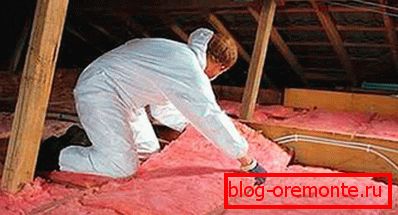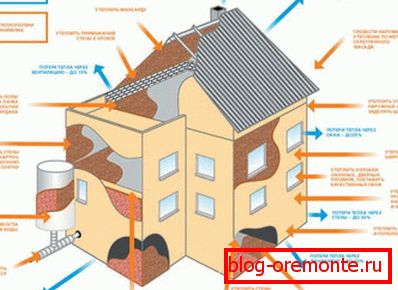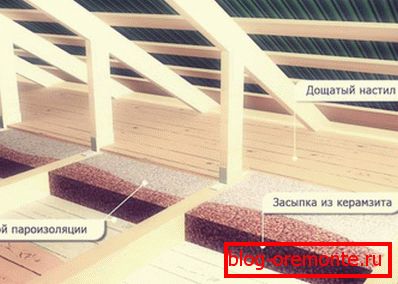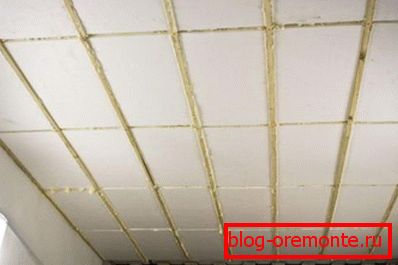How to insulate the ceiling under a cold roof - photo and
Currently, almost all residential buildings are heated with gas or electric heat-generating equipment. An exception is not even country and garden houses, which are used only in summer. Most of the buildings that are not used all year round are equipped with inexpensive cold-type roofs, through which the main heat losses occur while maintaining a comfortable temperature. In this article we will describe how to properly warm the ceiling under a cold roof, so that the house is always warm.
Features of the device cold roofs
Roof construction depends on the nature of the use of the house and the roofing space. It is on these factors that the choice of form, roofing material, the roof frame scheme and the presence or absence of the thermal insulation layer depends. In private housing construction use 2 types of roofs:
- Warm roof. This kind of roofing design provides full insulation of ramps. A warm roof is installed if the room located under the slopes is used as a dwelling. It is considered an excellent option for residential equipment attic. It makes sense to build roofs of this type for houses used and heated all year round, since they exclude heat losses through the slopes. The cost of materials and installation work on the construction of a warm roof is much higher than the cost of building a cold one.


- Cold roof. Roofs of the cold type do not have the usual structure obtained by layering a hydro-ventilation, thermo-insulating and roofing material. It is being built for houses in which the attic is not used as residential in winter and is not heated. Cold roofing is a truss system on which a layer of waterproofing and roofing material is laid. It weighs less, is cheaper and easier to install than warm, so it is a practical solution for country housing.

Important! If the attic is not heated, then the air in it serves as a kind of buffer zone, which serves as thermal insulation and reduces heat loss. The air rising from the heated premises of the first floor according to the law of convection gradually cools and does not heat the surface of the ramps from the inside, so that no frost is formed on them.
To preserve heat and also reduce fuel consumption to maintain the optimum temperature, with the help of backfill or fiber insulation materials, the ceiling under the cold roof is insulated. Since the heated air always rises, this operation is an effective measure to reduce heat loss.
Thermal insulation methods
High-quality thermal insulation reduces heat loss and the cost of heating a house by 30%, which is a good saving for the family budget. The use of suitable insulation and the correct choice of method of installation form a comfortable microclimate in the room. The issue of thermal insulation of the ceiling under a cold roof is better to be solved at the stage of building a house, then you can choose the most effective and convenient option. Most often the heater is mounted in 2 ways:
- Insulation from the attic. The most effective and correct builders consider insulation of the ceiling, located under the cold roof from the attic. The fact is, the ceiling is most often constructed of wood, which in itself is a good peat insulation material. In this case, the insulation is placed on the attic floor and closed the draft floor. If the insulation is performed from the attic, then you can use materials in the form of slabs or backfill.

- Insulation from the first floor. In cases where there is no access to the attic, when reconstructions of old houses with finished attic flooring are performed, thermal insulation is performed from the first floor. For this purpose, a frame made of metal profiles or wooden slats is mounted on the ceiling, insulation plates are placed there, and then sheathed with plasterboard. The disadvantage of this method is that it reduces the height of the ceiling. In addition, installation at the top is always much more difficult and longer. The effectiveness of this method of insulation is less, so it is used when there is no other way to reduce heat loss without dismantling the floors.

Note! Any thermal insulation works in a complex. Therefore, if you want to solve problems with heat-tracing in a house with a cold roof, howl about thermal insulation of the floor, door and window openings. An illustrative way to analyze where the heat goes is to look at a house in a thermal imager in winter. To improve the energy efficiency of the house, you need to pay attention to the zones painted in red and yellow, it is through them that the heat escapes.

Materials
The modern construction market offers an impressive range of materials for thermal insulation, but not all of them are suitable for insulating the ceiling under a cold roof. In order for the costs to recover, it is necessary that the insulating layer is resistant to moisture, has a low thermal conductivity and meets the safety standards for human health. For insulation use the following materials:
- Expanded clay. Expanded clay is called a backfill insulation type, which is obtained by firing shale. It has a light weight, porous structure and high insulating properties, but is afraid of moisture. To insulate the ceiling with this material, a vapor barrier is laid on the attic floor, fixed with a construction stapler, and then clay is covered with a layer of 15-30 cm.

- Mineral wool. Mineral wool - fibrous insulation based on minerals, produced in the form of mats, plates or rolls. This material is considered the most effective for thermal insulation of the ceiling, however, it costs more. Mineral wool perfectly retains heat, has good sound insulation properties, but weighs quite a lot. When using such a heater, you need to take care of high-quality vapor barrier and waterproofing, as it loses most of its properties when wet. Mineral wool is placed between the floor logs, and then closed with a finishing coating.

- Styrofoam. Polyfoam is called insulation based on foamed polystyrene foam, however, this substance makes up only a few percent of the composition of the material. More than 95% of the foam is air, so it is light and retains heat well. Polystyrene foam insulation is easy to cut and fix, they also fit between the attic floor lags. The main advantage of the foam is that it does not absorb moisture and does not lose its insulating properties upon contact with it.

Skilled craftsmen remind that the vapor barrier and waterproofing layers play an important role in the insulation of the floor located under the cold roof. To protect the insulation from wetting as a result of interaction with heated air saturated with water vapor, first install the vapor barrier membrane. And from the side of the roof it is protected from leakage by means of a waterproofing film.